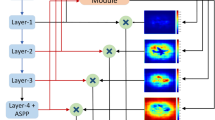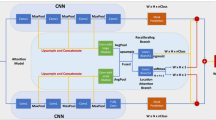Abstract
The fusion of multi-scale features has been an effective method to get state-of-the-art performance in semantic segmentation. In this work, we concentrate on two tricky problems—the intra-class inconsistency and the blur on the localization of object boundaries and tackle them by combining two separate multi-scale context features respectively. Specifically, we propose a dual-stream structure with the scale context selection attention module to enhance the capabilities for multi-scale processing, where one stream collects global-scale context and the other captures local-scale information. Meanwhile, the embedded scale context selection attention module in each stream can adaptively focus on different scale context information to get optimal scale features. Based on our dual-stream structure with attention modules, our network can efficiently make use of multi-scale context to generate more comprehensive and powerful features. Our experiments show that our dual-stream network with scale context selection attention module achieves promising performance on the PASCAL VOC 2012 and PASCAL-Person-Part datasets.









Similar content being viewed by others
References
Badrinarayanan V, Kendall A, Cipolla R (2017) SegNet: A deep convolutional encoder-decoder architecture for image segmentation. IEEE Trans Pattern Anal Mach Intell 39(12):2481–2495
Bahdanau D, Cho K, Bengio Y (2014) Neural machine translation by jointly learning to align and translate. arXiv e-prints, arXiv:1409.0473
Bansal A, Chen X, Russell B, Gupta A, Ramanan D (2017) PixelNet: representation of the pixels, by the pixels, and for the pixels. arXiv e-prints, arXiv:1702.06506
Buyssens P, Elmoataz A, Lézoray O (2012) Multiscale convolutional neural networks for vision-based classification of cells. In: Lee KM, Matsushita Y, Rehg JM, Hu Z (eds) Computer vision—ACCV 2012. Springer, Berlin, pp 342–352
Chen L.-C, Papandreou G, Kokkinos I, Murphy K, Yuille AL (2014) Semantic image segmentation with deep convolutional nets and fully connected CRFs. arXiv e-prints, arXiv:1412.7062
Chen L.-C, Papandreou G, Kokkinos I, Murphy K, Yuille AL (2016) DeepLab: semantic image segmentation with deep convolutional nets, atrous convolution, and fully connected CRFs. arXiv e-prints, arXiv:1606.00915
Chen L.-C, Papandreou G, Schroff F, Adam H (2017) Rethinking atrous convolution for semantic image segmentation. arXiv e-prints, arXiv:1706.05587
Chen L.-C, Papandreou G, Yuille AL (2013) Learning a dictionary of shape epitomes with applications to image labeling. In: 2013 IEEE international conference on computer vision. IEEE
Chen L.-C, Yang Y, Wang J, Xu W, Yuille AL (2015) Attention to scale: scale-aware semantic image segmentation. arXiv e-prints, arXiv:1511.03339
Chen X, Mottaghi R, Liu X, Fidler S, Urtasun R, Yuille A (2014) Detect what you can: detecting and representing objects using holistic models and body parts. arXiv e-prints, arXiv:1406.2031
Chen Z, Chen C, Jin X, Liu Y, Cheng Z (2019) Deep joint two-stream Wasserstein auto-encoder and selective attention alignment for unsupervised domain adaptation. Neural Comput Appl. https://doi.org/10.1007/s00521-019-04262-1
Everingham M, Eslami SMA, Van Gool L, Williams CKI, Winn J, Zisserman A (2015) The pascal visual object classes challenge: a retrospective. Int J Comput Vis 111(1):98–136
Farabet C, Couprie C, Najman L, LeCun Y (2013) Learning hierarchical features for scene labeling. IEEE Trans Pattern Anal Mach Intell 35(8):1915–1929
Fu J, Liu J, Tian H, Li Y, Bao Y, Fang Z, Lu H (2018) Dual attention network for scene segmentation. arXiv e-prints, arXiv:1809.02983
Ganin Y, Lempitsky V (2015) N4-fields: neural network nearest neighbor fields for image transforms. In: Cremers D, Reid I, Saito H, Yang M-H (eds) Computer vision—ACCV 2014. Springer, Cham, pp 536–551
Garcia-Garcia A, Orts-Escolano S, Oprea S, Villena-Martinez V, Rodríguez JG (2017) A review on deep learning techniques applied to semantic segmentation. CoRR, arXiv:1704.06857
Ghiasi G, Fowlkes CC (2016) Laplacian pyramid reconstruction and refinement for semantic segmentation. arXiv e-prints, arXiv:1605.02264
Hariharan B, Arbelaez P, Bourdev L, Maji S, Malik J (2011) Semantic contours from inverse detectors. In: 2011 international conference on computer vision. IEEE
He C, Hu H (2018) Image captioning with text-based visual attention. Neural Process Lett 49(1):177–185
He K, Zhang X, Ren S, Sun J (2014) Spatial pyramid pooling in deep convolutional networks for visual recognition. CoRR, arXiv:1406.4729
He K, Zhang X, Ren S, Sun J (2015) Deep residual learning for image recognition. arXiv e-prints, page arXiv:1512.03385
Hong C, Yu J, Wan J, Tao D, Wang M (2015) Multimodal deep autoencoder for human pose recovery. IEEE Trans Image Process 24(12):5659–5670
Hong C, Yu J, Zhang J, Jin X, Lee K (2019) Multimodal face-pose estimation with multitask manifold deep learning. IEEE Trans Ind Inf 15(7):3952–3961
Hu J, Shen L, Albanie S, Sun G, Wu E (2017) Squeeze-and-excitation networks. arXiv e-prints, arXiv:1709.01507
Kim J, Bukhari W, Lee M (2017) Feature analysis of unsupervised learning for multi-task classification using convolutional neural network. Neural Process Lett 47(3):783–797
Krizhevsky A, Sutskever I, Hinton GE (2012) Imagenet classification with deep convolutional neural networks. Neural Inf Process Syst 25:01
Lazebnik S, Schmid C, Ponce J (2006) Beyond bags of features: spatial pyramid matching for recognizing natural scene categories. In: 2006 IEEE computer society conference on computer vision and pattern recognition (CVPR’06), vol 2, pp 2169–2178
Lee C.-Y, Xie S, Gallagher P, Zhang Z, Tu Z (2014) Deeply-supervised nets. arXiv e-prints, arXiv:1409.5185
Liang X, Shen X, Feng J, Lin L, Yan S (2016) Semantic object parsing with graph LSTM. arXiv e-prints, arXiv:1603.07063
Liang X, Shen X, Xiang D, Feng J, Lin L, Yan S (2015) Semantic object parsing with local-global long short-term memory. arXiv e-prints, arXiv:1511.04510
Lin G, Milan A, Shen C, Reid I (2017) Refinenet: multi-path refinement networks for high-resolution semantic segmentation. In: The IEEE conference on computer vision and pattern recognition (CVPR)
Lin G, Shen C, van dan Hengel A, Reid I (2015) Efficient piecewise training of deep structured models for semantic segmentation. arXiv e-prints, arXiv:1504.01013
Liu W, Rabinovich A, Berg AC (2015) ParseNet: looking wider to see better. arXiv e-prints, arXiv:1506.04579
Liu Z, Li X, Luo P, Change Loy C, Tang X (2015) Semantic image segmentation via deep parsing network. arXiv e-prints, arXiv:1509.02634
Mnih V, Heess N, Graves A, Kavukcuoglu K (2014) Recurrent models of visual attention. arXiv e-prints, arXiv:1406.6247
Neverova N, Wolf C, Taylor GW, Nebout F (2015) Multi-scale deep learning for gesture detection and localization. In: Agapito L, Bronstein MM, Rother C (eds) Computer vision—ECCV 2014 workshops. Springer, Cham, pp 474–490
Noh H, Hong S, Han B (2015) Learning deconvolution network for semantic segmentation. In: 2015 IEEE international conference on computer vision (ICCV). IEEE
Papandreou G, Chen L.-C, Murphy K, Yuille AL (2015) Weakly- and semi-supervised learning of a DCNN for semantic image segmentation. arXiv e-prints, arXiv:1502.02734
Peng C, Zhang X, Yu G, Luo G, Sun J (2017) Large kernel matters—improve semantic segmentation by global convolutional network. In: The IEEE conference on computer vision and pattern recognition (CVPR)
Pohlen T, Hermans A, Mathias M, Leibe B (2017) Full-resolution residual networks for semantic segmentation in street scenes. In: The IEEE conference on computer vision and pattern recognition (CVPR)
Shelhamer E, Long J, Darrell T (2017) Fully convolutional networks for semantic segmentation. IEEE Trans Pattern Anal Mach Intell 39(4):640–651
Shuai B, Zuo Z, Wang B, Wang G (2018) Scene segmentation with DAG-recurrent neural networks. IEEE Trans Pattern Anal Mach Intell 40(6):1480–1493
Vaswani A, Shazeer N, Parmar N, Uszkoreit J, Jones L, Gomez AN, Kaiser L, Polosukhin I (2017) Attention is all you need. arXiv e-prints, arXiv:1706.03762
Wang P, Chen P, Yuan Y, Liu D, Huang Z, Hou X, Cottrell G (2017) Understanding convolution for semantic segmentation. arXiv e-prints, arXiv:1702.08502
Wang X, Girshick RB, Gupta A, He K (2017) Non-local neural networks. CoRR, arXiv:1711.07971
Woo S, Park J, Lee J.-Y, Kweon IS (2018) CBAM: convolutional block attention module. arXiv e-prints, arXiv:1807.06521
Xia F, Wang P, Chen L.-C, Yuille AL (2015) Zoom better to see clearer: human and object parsing with hierarchical auto-zoom net. arXiv e-prints, arXiv:1511.06881
Xiao Y, Codevilla F, Gurram A, Urfalioglu O, López AM (2019) Multimodal end-to-end autonomous driving. arXiv e-prints, arXiv:1906.03199
Xu K, Ba J, Kiros R, Cho K, Courville A, Salakhutdinov R, Zemel R, Bengio Y (2015) Show, attend and tell: neural image caption generation with visual attention. arXiv e-prints, arXiv:1502.03044
Yu C, Wang J, Peng C, Gao C, Yu G, Sang N (2018) Learning a discriminative feature network for semantic segmentation. arXiv e-prints, arXiv:1804.09337
Yu J, Rui Y, Tao D (2014) Click prediction for web image reranking using multimodal sparse coding. IEEE Trans Image Process 23(5):2019–2032
Yu J, Tan M, Zhang H, Tao D, Rui Y (2019) Hierarchical deep click feature prediction for fine-grained image recognition. IEEE Trans Pattern Anal Mach Intell. https://doi.org/10.1109/TPAMI.2019.2932058
Yu J, Yang X, Gao F, Tao D (2017) Deep multimodal distance metric learning using click constraints for image ranking. IEEE Trans Cybern 47(12):4014–4024
Yu J, Zhang B, Kuang Z, Lin D, Fan J (2017) iPrivacy: image privacy protection by identifying sensitive objects via deep multi-task learning. IEEE Trans Inf Forensics Secur 12(5):1005–1016
Yu J, Zhu C, Zhang J, Huang Q, Tao D (2019) Spatial pyramid-enhanced NetVLAD with weighted triplet loss for place recognition. IEEE Trans Neural Netw Learn Syst. https://doi.org/10.1109/TNNLS.2019.2908982
Zhang H, Dana K, Shi J, Zhang Z, Wang X, Tyagi A, Agrawal A (2018) Context encoding for semantic segmentation. arXiv e-prints, arXiv:1803.08904
Zhang J, Yu J, Tao D (2018) Local deep-feature alignment for unsupervised dimension reduction. IEEE Trans Image Process 27(5):2420–2432
Zhang W, Hu H, Hu H (2018) Training visual-semantic embedding network for boosting automatic image annotation. Neural Process Lett 48(3):1503–1519
Zhao H, Shi J, Qi X, Wang X, Jia J (2016) Pyramid scene parsing network. CoRR, arXiv:1612.01105
Zhao H, Zhang Y, Liu S, Shi J, Loy CC, Lin D, Jia J (2018) Psanet: point-wise spatial attention network for scene parsing. In: Ferrari V, Hebert M, Sminchisescu C, Weiss Y (eds) Computer vision—ECCV 2018. Springer, Cham, pp 270–286
Zheng S, Jayasumana S, Romera-Paredes B, Vineet V, Su Z, Du D, Huang C, Torr PHS (2015) Conditional random fields as recurrent neural networks. arXiv e-prints, arXiv:1502.03240
Acknowledgements
This work was supported by the Opening Foundation of the State Key Laboratory (No. 2014KF06), and the National Science and Technology Major Project (No. 2013ZX03005013).
Author information
Authors and Affiliations
Corresponding author
Ethics declarations
Conflict of interest
The authors declare that they have no conflict of interest.
Additional information
Publisher's Note
Springer Nature remains neutral with regard to jurisdictional claims in published maps and institutional affiliations.
Rights and permissions
About this article
Cite this article
Liu, Y., Xu, C., Chen, Z. et al. Deep Dual-Stream Network with Scale Context Selection Attention Module for Semantic Segmentation. Neural Process Lett 51, 2281–2299 (2020). https://doi.org/10.1007/s11063-019-10148-z
Published:
Issue Date:
DOI: https://doi.org/10.1007/s11063-019-10148-z




